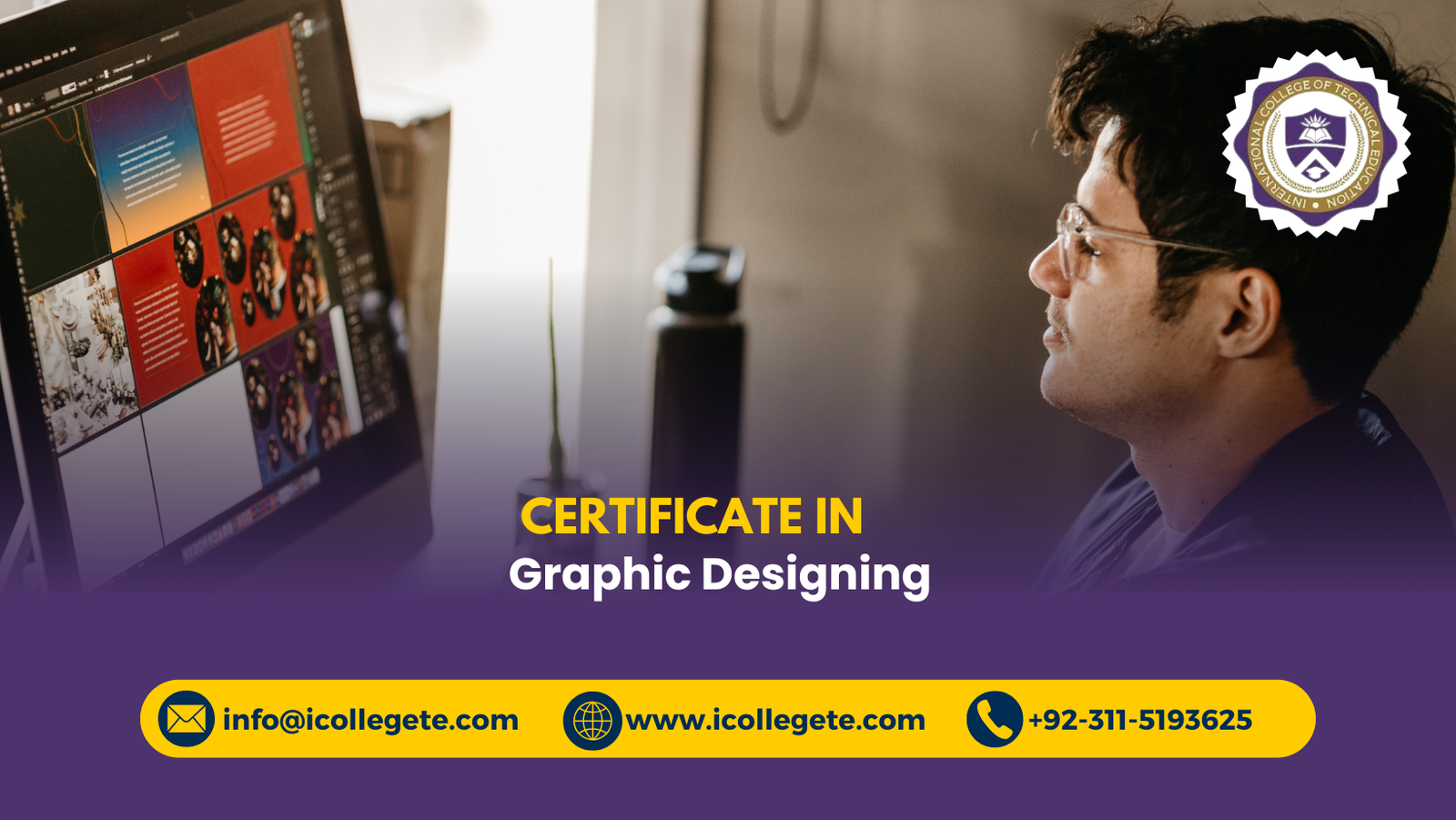In today’s visually-driven world, graphic design plays a pivotal role in communication, branding, and marketing across all industries. Whether it’s a logo, advertisement, website layout, or social media content, the power of effective design cannot be overstated. A Graphic Designing Course in Pakistan provides aspiring designers with the skills, knowledge, and creativity needed to succeed in this exciting and fast-paced field. Whether you’re looking to pursue a full-time career as a graphic designer or enhance your design skills for personal or professional projects, this course offers the right foundation to get started.
The Graphic Designing Course is designed to teach individuals the essential principles of graphic design, including the use of design software, understanding visual communication, and applying design theory to create aesthetically pleasing and functional designs. Through this course, students will explore both the creative and technical aspects of graphic design, learning how to translate concepts into visual solutions that resonate with audiences.
This course is suitable for beginners, individuals looking to switch careers, or anyone who wishes to enhance their design skills to keep up with the growing demand for visual content in today’s digital world. Upon completion of the course, students will be equipped with the skills necessary to work on a wide range of design projects, from logos and brochures to advertisements and digital marketing materials.
The Graphic Designing Course in Pakistan offers a comprehensive curriculum that covers various aspects of design, both traditional and digital. It includes an introduction to the history of design, color theory, typography, visual hierarchy, and branding principles. The course also teaches industry-standard design software such as Adobe Photoshop, Illustrator, and InDesign, which are essential tools for creating professional-level designs.
Throughout the course, students will learn how to conceptualize, create, and refine their designs based on client needs and design briefs. Emphasis is placed on creativity, attention to detail, and delivering high-quality work that is both aesthetically pleasing and functional. Students will also gain hands-on experience working with real-life projects, which will help them build a strong portfolio to showcase their skills to potential employers or clients.
Study Units
The Graphic Designing Course is structured into several key study units that cover a wide range of topics in graphic design. Some of the core units include:
- Introduction to Graphic Design – An overview of the field, including the role of a graphic designer, the history of graphic design, and its significance in communication.
- Design Principles – Learning the basic principles of design, such as balance, contrast, alignment, proximity, and repetition, which are essential for creating effective and visually appealing designs.
- Typography – Understanding the importance of typography, selecting fonts, and creating effective text layouts for various design projects.
- Color Theory – Exploring the psychological impact of colors and how to choose color schemes that evoke the right emotions and complement the overall design.
- Software Skills (Photoshop, Illustrator, InDesign) – Practical training in industry-standard graphic design software, including how to use these tools to create digital graphics, logos, brochures, posters, and more.
- Logo Design – Learning the process of designing logos, from concept to completion, and understanding the role of a logo in branding and identity.
- Layout Design – Techniques for designing layouts for print and digital media, ensuring content is arranged in a visually appealing and easy-to-read format.
- Image Editing and Manipulation – Developing the skills to edit and manipulate images to suit various design needs, including retouching, resizing, and creating visual effects.
- Packaging Design – Understanding the principles of designing packaging, labels, and product branding, with an emphasis on consumer psychology and visual appeal.
- Web and Mobile Design – Introduction to designing graphics for websites and mobile applications, focusing on user experience (UX) and interface design (UI).
- Design Portfolio Development – Creating a professional portfolio that showcases your best work, which is essential for securing employment or freelance opportunities.
Learning Outcomes
Upon completing the Graphic Designing Course, students will be able to:
- Master Design Software – Gain proficiency in key graphic design software such as Adobe Photoshop, Illustrator, and InDesign, which are essential for any graphic designer.
- Understand Design Theory – Develop a strong foundation in design principles such as balance, contrast, alignment, and hierarchy, which are crucial for creating effective designs.
- Create Various Design Projects – Ability to design logos, brochures, posters, web graphics, packaging, and more, applying design theory to real-world projects.
- Enhance Typography Skills – Understand how to use fonts and typefaces effectively, creating well-composed text layouts for both print and digital media.
- Build a Professional Portfolio – Develop a portfolio showcasing the best design work that demonstrates the breadth and depth of your skills.
- Work with Clients and Design Briefs – Learn how to interpret and respond to client feedback, working with design briefs to meet client expectations and deadlines.
- Create User-Friendly Designs – Understand the basics of UX and UI design to create graphics and layouts that are visually appealing and easy to navigate.
Course Benefits
Enrolling in the Graphic Designing Course offers several benefits, including:
- Comprehensive Skill Development – Students gain a broad range of skills that make them versatile graphic designers capable of working on various design projects.
- Practical Experience – The course provides hands-on experience working with design software and creating real-world projects that can be included in a professional portfolio.
- Industry-Recognized Certification – Upon completion, students receive a certificate that adds credibility to their skills and helps them stand out in the competitive design job market.
- Increased Career Opportunities – With the growing demand for graphic designers in industries such as advertising, marketing, branding, and digital media, this course opens up numerous career paths.
- Creative Expression – Graphic design allows individuals to explore and express their creativity while solving communication problems through visual means.
- Freelancing Potential – Graphic design is a highly sought-after skill in the freelancing world, and this course prepares students to take on freelance design projects and clients.
- Portfolio Development – Students build a portfolio of work that demonstrates their skills, which is essential for securing job opportunities or attracting clients as a freelancer.
Who Is This Course For?
The Graphic Designing Course in Pakistan is ideal for:
- Beginners who are interested in learning graphic design and want to enter the creative industry.
- Aspiring Designers looking to develop or enhance their skills in graphic design to pursue a career in the field.
- Creative Individuals who enjoy visual communication and want to turn their passion into a professional career.
- Marketing and Branding Professionals who want to add design skills to their existing knowledge and improve their company’s visual communication.
- Freelancers who wish to offer graphic design services to clients and build their own design business.
- Entrepreneurs who want to design their own marketing materials, websites, logos, and other visual content for their business.
Future Progression
Upon completing the Graphic Designing Course, there are numerous opportunities for career advancement and further study:
- Advanced Graphic Design Courses – Graduates can pursue specialized courses in areas such as web design, UX/UI design, 3D modeling, or animation to deepen their expertise.
- Freelancing and Self-Employment – Many graphic designers opt to freelance, offering design services to clients across various industries, such as advertising, media, and publishing.
- Digital Marketing and Branding – With strong graphic design skills, individuals can transition into digital marketing, focusing on social media graphics, email marketing design, or brand strategy.
- Web and App Design – Those with an interest in technology may choose to specialize in designing graphics for websites and mobile applications, integrating their design skills with user experience (UX) principles.
- Further Studies in Art and Design – Graduates may choose to pursue higher education in art, design, or digital media, broadening their knowledge and skills in the creative field.
- Creative Director – With experience, graphic designers can move into senior roles such as creative director, where they lead design teams and manage large-scale projects.
The Graphic Designing Course in Pakistan provides a robust foundation for anyone interested in the design field, helping students develop both the creative and technical skills required to succeed in this competitive industry. Whether you’re looking to enter the workforce, freelance, or advance your career, this cours






